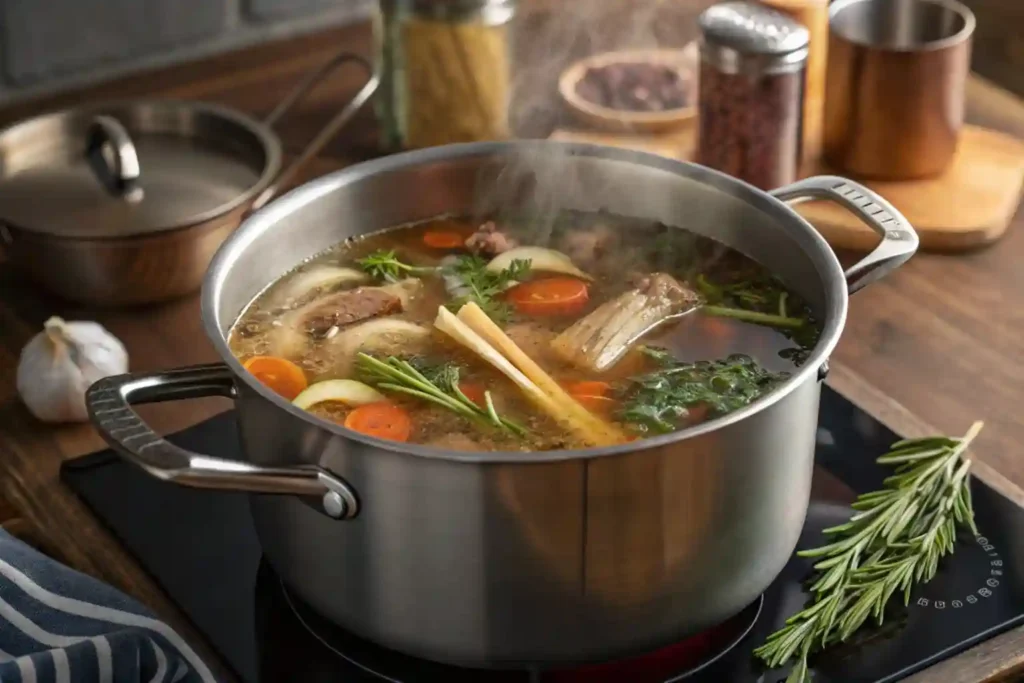Table of Contents
1. What is a Soup Bone?
A soup bone is a term used to describe bones that are specifically used to make broth or stock. These bones are rich in flavor and nutrients, making them an essential ingredient in many culinary traditions. Understanding what soup bones are and how they can enhance your cooking is crucial for anyone looking to create delicious, hearty dishes.
Common Types of Soup Bones
When it comes to soup bones, there are several types that you can use, each offering unique flavors and benefits. Here are some of the most common types:
- Beef Bones: Often used for hearty broths, beef bones can include shank bones, marrow bones, and oxtails. These bones provide a rich, robust flavor that is perfect for winter soups and stews.
- Chicken Bones: Ideal for lighter broths, chicken bones are typically sourced from whole chickens or leftover carcasses. They create a delicate, flavorful broth that is perfect for chicken noodle soup or as a base for sauces.
- Pork Bones: These can add a unique flavor to soups and are often used in Asian cuisines. Pork bones, such as neck bones or trotters, can impart a slightly sweet and savory taste to your broth.
- Fish Bones: Used for making delicate fish stocks, these bones impart a subtle flavor. Fish bones are often combined with vegetables and herbs to create a light broth that is perfect for seafood dishes.
Nutritional Benefits of Using Soup Bones
Using soup bones in your cooking not only enhances flavor but also provides several health benefits. Here are some of the key nutritional advantages:
- Rich in Collagen: When simmered, bones release collagen, which can support joint health and improve skin elasticity. Collagen is essential for maintaining the structure of your skin, joints, and connective tissues.
- Mineral Content: Bones are a source of essential minerals like calcium, magnesium, and phosphorus, which are vital for bone health. These minerals can help strengthen your bones and teeth, making them an important part of a balanced diet.
- Amino Acids: The slow cooking process extracts amino acids, which are the building blocks of proteins and important for overall health. Amino acids play a crucial role in muscle repair, immune function, and hormone production.
Incorporating soup bones into your cooking can elevate your dishes while also providing essential nutrients that support your health.
2. What is a Soup Bone Slang?
The term soup bone can also have slang connotations, often varying by region and context. Understanding these nuances can enrich your culinary vocabulary and provide insight into how language evolves in different cultures.
Explanation of the Term “Soup Bone” in Slang
In some cultures, calling someone a “soup bone” can imply that they are not very useful or are seen as a burden. This usage often reflects a humorous or light-hearted take on someone’s perceived lack of contribution.
- Culinary Circles: In culinary circles, it may refer to a person who is inexperienced or lacks knowledge about cooking. For example, a novice cook might be affectionately called a “soup bone” by more experienced chefs.
Cultural References and Variations in Usage
The term soup bone can have different meanings depending on the cultural context. Here are some examples:
- Regional Variations: In certain areas, the term may be used affectionately to describe someone who enjoys cooking or is always in the kitchen. This positive connotation highlights the joy of cooking and sharing meals.
- Culinary Jargon: Chefs may use the term to refer to specific cuts of meat that are less desirable but can be transformed into delicious dishes when cooked properly. This reflects the creativity and resourcefulness often found in professional kitchens.
Examples of How the Term is Used in Everyday Language
Understanding how the term is used in everyday language can provide insight into its cultural significance. Here are a few examples:
- “Don’t be a soup bone; get in the kitchen and help out!” This playful remark encourages participation in cooking.
- “This recipe is so good, it’ll make you feel like a gourmet chef, not just a soup bone.” This highlights the transformative power of cooking and the joy it can bring.
By exploring the slang and cultural references associated with soup bones, you can gain a deeper appreciation for the language of cooking and its impact on our culinary experiences.
3. Are Soup Bones Good to Eat?
One of the most common questions about soup bones is whether they are good to eat. The answer is a resounding yes! Not only are they flavorful, but they also offer numerous health benefits.
Nutritional Value of Meat and Marrow from Soup Bones
The meat and marrow found in soup bones can be both delicious and nutritious. Here’s a closer look at their nutritional value:
- Meat: The meat that clings to the bones can be flavorful and tender when cooked properly. It often contains essential nutrients and proteins that contribute to a balanced diet. Using the meat from soup bones can enhance the overall flavor of your dishes.
- Marrow: Bone marrow is a delicacy in many cultures, rich in fat and nutrients. It can be spread on bread or added to soups for extra richness. Marrow is also a source of healthy fats, which can provide energy and support overall health.
Health Benefits of Consuming Bone Broth
Consuming bone broth made from soup bones can offer several health benefits:
- Gut Health: Bone broth is known for its gut-healing properties, thanks to the gelatin it contains, which can help seal holes in the gut lining. This can be particularly beneficial for individuals with digestive issues.
- Joint Support: The collagen and amino acids in bone broth can help reduce joint pain and inflammation. Regular consumption may support joint health, making it a popular choice for athletes and active individuals.
- Hydration: Bone broth is a hydrating liquid that can be consumed on its own or used as a base for soups and stews. Staying hydrated is essential for overall health, and bone broth can be a flavorful way to achieve this.
Comparison of Soup Bones to Other Meat Cuts
When considering the use of soup bones in your cooking, it’s helpful to compare them to other meat cuts:
- Flavor: Soup bones often provide a deeper, richer flavor compared to standard meat cuts, making them ideal for broths and stocks. The slow cooking process extracts flavors that enhance the overall taste of your dishes.
- Cost-Effectiveness: Using soup bones can be a more economical choice, as they are often less expensive than premium cuts of meat. This makes them an excellent option for budget-conscious cooks.
- Versatility: While other cuts may be limited to specific recipes, soup bones can be used in a variety of dishes, from traditional soups to modern culinary creations. Their adaptability makes them a valuable addition to any kitchen.
In summary, soup bones are not only good to eat but also offer a wealth of nutritional benefits. Incorporating them into your cooking can enhance flavor, improve health, and provide a cost-effective solution for delicious meals.
4. Can I Eat the Meat from Soup Bones?
One of the most frequently asked questions about soup bones is whether the meat attached to them is safe and enjoyable to eat. The answer is yes! The meat from soup bones can be both delicious and nutritious when prepared correctly.
How to Prepare and Eat the Meat from Soup Bones

When using soup bones, it’s essential to know how to extract and prepare the meat properly. Here are some steps to follow:
- Simmering: Start by simmering the soup bones in water for several hours. This process will not only extract the flavors from the bones but also tenderize the meat. Aim for a simmering time of at least 4-6 hours for optimal results.
- Straining: Once the broth is ready, strain the liquid to separate the bones and any solid particles. This will leave you with a clear, flavorful broth.
- Removing the Meat: After straining, allow the bones to cool slightly. Use a fork or your hands to pull off any meat that remains on the bones. This meat can be added back into the broth or used in other dishes.
Recipes That Utilize Meat from Soup Bones
The meat from soup bones can be used in various recipes, adding flavor and nutrition. Here are a few ideas:
- Hearty Soups: Add the meat back into your broth to create a hearty soup. Consider adding vegetables, grains, or noodles for a complete meal.
- Tacos or Burritos: Shred the meat and use it as a filling for tacos or burritos. Combine it with fresh toppings like salsa, avocado, and cilantro for a delicious meal.
- Salads: Use the meat as a protein source in salads. Toss it with greens, vegetables, and a flavorful dressing for a nutritious lunch or dinner.
Tips for Maximizing Flavor and Nutrition
To get the most out of the meat from soup bones, consider these tips:
- Seasoning: Don’t forget to season the broth and meat as you cook. Adding herbs, spices, and aromatics can enhance the overall flavor.
- Use Leftovers: If you have leftover meat, store it in the refrigerator for up to 3 days or freeze it for later use. This allows you to enjoy the benefits of soup bones in multiple meals.
- Experiment: Don’t be afraid to experiment with different types of meat and bones. Each type will impart a unique flavor to your dishes.
5. How Many Times Can I Reuse Soup Bones?

Another common question is how many times you can reuse soup bones to make broth. The answer depends on several factors, including the type of bones used and the cooking method.
Guidelines for Reusing Soup Bones in Broth-Making
- First Use: The first time you use soup bones, you’ll extract the most flavor and nutrients. This broth will be rich and full-bodied.
- Second Use: You can reuse the same bones to make a second batch of broth. However, the flavor will be less intense. It’s best to simmer for a shorter time, around 2-4 hours.
- Third Use: After the second use, the bones may still yield some flavor, but it will be significantly diminished. If you choose to reuse them, consider adding fresh ingredients like vegetables or herbs to enhance the flavor.
Signs That Soup Bones Have Been Overused
Knowing when to stop using soup bones is essential for maintaining the quality of your broth. Here are some signs that the bones have been overused:
- Lack of Flavor: If the broth tastes weak or bland, it’s a sign that the bones have given up their flavor.
- Texture Changes: If the bones appear crumbled or disintegrated, they may no longer be suitable for reuse.
- Color: A broth that is very light in color may indicate that the bones have been overused.
Tips for Storing and Reusing Bones Effectively
To maximize the use of your soup bones, consider these storage and reuse tips:
- Cool and Store: After making broth, allow the bones to cool before storing them in the refrigerator or freezer. This will help preserve their flavor for future use.
- Labeling: If you plan to reuse bones, label them with the date and number of times they’ve been used. This will help you keep track of their freshness.
- Combine with Fresh Ingredients: When reusing bones, consider adding fresh vegetables, herbs, and spices to enhance the flavor of the broth.
6. Conclusion and FAQs
In conclusion, soup bones are a versatile and nutritious ingredient that can elevate your cooking while providing numerous health benefits. From creating rich, flavorful broths to offering a cost-effective solution for delicious meals, understanding how to use soup bones can enhance your culinary repertoire. Whether you’re making a hearty soup, a delicate broth, or even treating your dog to a nutritious snack, soup bones are an essential component in many kitchens.
For those interested in exploring more about healthy eating, check out our article on Is Indian Food Healthy?. If you’re looking for specific recipes, consider trying our Village Soup Recipe, which can be enhanced with the addition of soup bones. And for a quick meal option, you might want to read about Healthy Choice Frozen Meals to see how they compare to homemade options.
FAQs
Here are some frequently asked questions about soup bones to further clarify their uses and benefits:
What is a soup bone?
A soup bone is a bone used specifically for making broth or stock. These bones are rich in flavor and nutrients, making them a key ingredient in many recipes. Common types include beef, chicken, pork, and fish bones.
What is a soup bone slang?
In slang, the term soup bone can refer to someone who is perceived as not very useful or as a burden. In culinary contexts, it may describe someone inexperienced in cooking. The term can vary in meaning based on cultural references.
Are soup bones good to eat?
Yes, the meat and marrow from soup bones are not only safe to eat but also nutritious. They provide essential nutrients, including collagen, amino acids, and minerals, which can benefit your health.
Can I eat the meat from soup bones?
Absolutely! The meat that clings to soup bones can be flavorful and tender when cooked properly. It can be used in various recipes, such as soups, tacos, and salads.
How many times can I reuse soup bones?
You can typically reuse soup bones for making broth two to three times. The first use will yield the richest flavor, while subsequent uses will produce lighter broths. Be mindful of the signs of overuse, such as lack of flavor or texture changes.
Are raw beef soup bones ok for dogs?
Yes, raw beef soup bones can be safe for dogs when handled properly. They provide nutritional benefits and can help with dental health. Always supervise your dog while they chew on bones and choose appropriately sized options.
